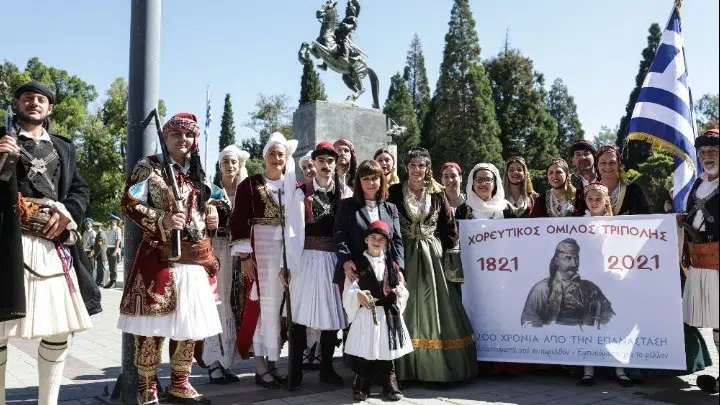
President of the Hellenic Republic Katerina Sakellaropoulou on Sunday attended events commemorating the bicentennial of the siege of Tripolis by Greeks struggling for independence from the Ottoman Turks.
The siege of Tripolitsa, Greece (today’s city of Tripolis) was a pivotal moment in the Greek War of Independence and it remains a point of contention between Greeks and Turks, as reflected in the way it is portrayed by their respective historians. It took place on September 23 1821.
After attending a church service and laying wreaths at monuments in Platia Areos, Sakellaropoulou said that the siege that took place a few months after the start of the revolution was a pivotal event in the Greek War of Independence, establishing the revolution in the Peloponnese and inspiring the revolting Greeks.
“The decision of Theodoros Kolokotronis to conquer the administrative and military center of the Ottomans proved to be of top strategic importance, as it consolidated the Revolution in the Peloponnese, reviving the morale of the Greeks.
“Two hundred years later, our homeland is a modern state of law in the heart of the European Union that guarantees stability and peaceful coexistence in the region, without giving up its sovereign rights,” she noted.
The president also attended a parade and was given a tour of the Collection of Georgios Gaitanaris and Io Dolka on “Depictions & Reconstructions of the Greek-speaking World from the 18th to the 21st Centuries” at the Apostolopoulio Cultural Center.
The siege (and the ensuing massacre) at Tripolis was an early victory for the Greeks, just six months after the declaration of the War of Independence in March 1821, but it also became notorious for the atrocities against the Muslim inhabitants of the city and the Jews who entered the city, terrified by the wrath of the Greek rebels after the siege.
Siege of Tripolis remembered
Situated in the middle of the Peloponnesian peninsula, Tripolitsa was the preeminent town in southern Greece, as well as the administrative center for Ottoman rule in the Peloponnese, thus making it an important target for the Greek revolutionaries.
Many rich Turks and Jews lived there, together with Ottoman refugees driven there by the outbreak of the revolt, escaping massacres in the country’s southern districts.
The commander in chief of the Greek rebels, Theodoros Kolokotronis, confirms both the eyewitnesses and later historians concerning the massacre. He writes in his memoirs: “Inside the town they had begun to massacre. … I rushed to the palace … ‘If you wish to hurt these Albanians,’ I cried, ‘kill me rather; for, while I am a living man, whoever first makes the attempt, him will I kill the first.’
“I was faithful to my word of honor… Tripolitsa was three miles in circumference. The (Greek) host which entered it, cut down and were slaying men, women, and children from Friday till Sunday. Thirty-two thousand were reported to have been slain. One Hydriot (boasted that he had) killed ninety. About a hundred Greeks were killed; but the end came (thus): a proclamation was issued that the slaughter must cease.”
The capture of the city of Tripolis inarguably had a salutary effect on the morale of the revolutionaries. After this event, Greeks saw that their way toward victory was possible, with the entire Peloponnese now bearing hardly any trace of Ottomans.
See all the latest news from Greece and the world at Greekreporter.com. Contact our newsroom to report an update or send your story, photos and videos. Follow GR on Google News and subscribe here to our daily email!



